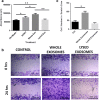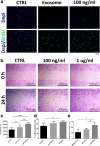Exosomes from acellular Wharton's jelly of the human umbilical cord promotes skin wound healing
- PMID: 30005703
- PMCID: PMC6044104
- DOI: 10.1186/s13287-018-0921-2
Exosomes from acellular Wharton's jelly of the human umbilical cord promotes skin wound healing
Abstract
Background: Compromised wound healing has become a global public health challenge which presents a significant psychological, financial, and emotional burden on patients and physicians. We recently reported that acellular gelatinous Wharton's jelly of the human umbilical cord enhances skin wound healing in vitro and in vivo in a murine model; however, the key player in the jelly which enhances wound healing is still unknown.
Methods: We performed mass spectrometry on acellular gelatinous Wharton's jelly to elucidate the chemical structures of the molecules. Using an ultracentrifugation protocol, we isolated exosomes and treated fibroblasts with these exosomes to assess their proliferation and migration. Mice were subjected to a full-thickness skin biopsy experiment and treated with either control vehicle or vehicle containing exosomes. Isolated exosomes were subjected to further mass spectrometry analysis to determine their cargo.
Results: Subjecting the acellular gelatinous Wharton's jelly to proteomics approaches, we detected a large amount of proteins that are characteristic of exosomes. Here, we show that the exosomes isolated from the acellular gelatinous Wharton's jelly enhance cell viability and cell migration in vitro and enhance skin wound healing in the punch biopsy wound model in mice. Mass spectrometry analysis revealed that exosomes of Wharton's jelly umbilical cord contain a large amount of alpha-2-macroglobulin, a protein which mimics the effect of acellular gelatinous Wharton's jelly exosomes on wound healing.
Conclusions: Exosomes are being enriched in the native niche of the umbilical cord and can enhance wound healing in vivo through their cargo. Exosomes from the acellular gelatinous Wharton's jelly and the cargo protein alpha-2-macroglobulin have tremendous potential as a noncellular, off-the-shelf therapeutic modality for wound healing.
Keywords: Exosomes; Skin; Stem cells; Umbilical cord; Wharton’s jelly; Wound healing.
Conflict of interest statement
Ethics approval and consent to participate
The animal experiments were reviewed and approved, and performed in accordance with the guidelines and regulations set forth by the Sunnybrook Research Institute and Sunnybrook Health Sciences Animal Policy and Welfare Committee of the University of Toronto, Ontario Canada. All procedures using animals were approved by the Sunnybrook animal care committee, approval #15–503(M-1) issued 20 Nov 2015 under the auspices of Canadian Council on Animal care.
Human umbilical cords were obtained from cesarean sections performed by surgeons from the Department of Gynecology and Obstetrics at Sunnybrook Health Sciences Centre, University of Toronto, Toronto, Ontario, Canada. All subjects gave written informed consent in accordance with the Declaration of Helsinki Principles. The protocol was approved by Toronto Academic Health Sciences Network (TAHSN) and University of Toronto-affiliated Sunnybrook Research Institute and Sunnybrook Health Sciences Centre Institutional Ethics Review Board approval (REB number: 017–2011), and after obtaining patient signed informed consent.
Normal human skin was obtained from Toronto General Hospital a part of United Health Network (UHN). This skin was “left-over” from abdominal flap tissue that was obtained by surgeons from the Division of Plastic Surgery as a part of breast reconstruction surgery. This sample is left-over or trimmed for the shaping of the flap and would normally be discarded. Patients gave written informed consent in accordance with the Declaration of Helsinki Principles. The protocol was approved by UHN Research Ethics Board (REB) (approval# 13–6437-CE) issued 24 May 2016.
Consent for publication
Not applicable.
Competing interests
The authors declare that they have no competing interests.
Publisher’s Note
Springer Nature remains neutral with regard to jurisdictional claims in published maps and institutional affiliations.
Figures





References
-
- W.H.O. (WHO), in, http://www.who.int/en/news-room/fact-sheets/detail/burns, 2018.
Publication types
MeSH terms
Grants and funding
LinkOut - more resources
Full Text Sources
Other Literature Sources

